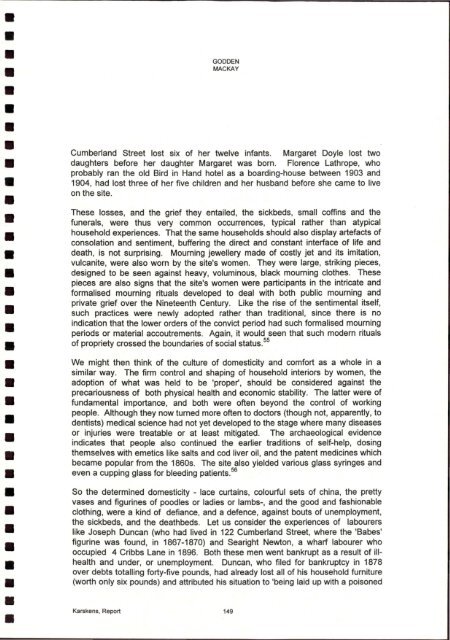Private Pleasures
Private Pleasures
Private Pleasures
You also want an ePaper? Increase the reach of your titles
YUMPU automatically turns print PDFs into web optimized ePapers that Google loves.
GODDEN<br />
MACKAY<br />
Cumberland Street lost six of her twelve infants. Margaret Doyle lost two<br />
daughters before her daughter Margaret was born. Florence Lathrope, who<br />
probably ran the old Bird in Hand hotel as a boarding-house between 1903 and<br />
1904, had lost three of her five children and her husband before she came to live<br />
on the site.<br />
These losses, and the grief they entailed, the sickbeds, small coffins and the<br />
funerals, were thus very common occurrences, typical rather than atypical<br />
household experiences. That the same households should also display artefacts of<br />
consolation and sentiment, buffering the direct and constant interface of life and<br />
death, is not surprising. Mourning jewellery made of costly jet and its imitation,<br />
vulcanite, were also worn by the site's women. They were large, striking pieces,<br />
designed to be seen against heavy, voluminous, black mourning clothes. These<br />
pieces are also signs that the site's women were participants in the intricate and<br />
formalised mourning rituals developed to deal with both public mourning and<br />
private grief over the Nineteenth Century. Like the rise of the sentimental itself,<br />
such practices were newly adopted rather than traditional, since there is no<br />
indication that the lower orders of the convict period had such formalised mourning<br />
periods or material accoutrements. Again, it would seen that such modern rituals<br />
of propriety crossed the boundaries of social status. 55<br />
We might then think of the culture of domesticity and comfort as a whole in a<br />
similar way. The firm control and shaping of household interiors by women, the<br />
adoption of what was held to be 'proper, should be considered against the<br />
precariousness of both physical health and economic stability. The latter were of<br />
fundamental importance, and both were often beyond ·the control of working<br />
people. Although they now turned more often to doctors {though not, apparently, to<br />
dentists) medical science had not yet developed to the stage where many diseases<br />
or injuries were treatable or at least mitigated. The archaeological evidence<br />
indicates that people also continued the earlier traditions of self-help, dosing<br />
themselves with emetics like salts and cod liver oil, and the patent medicines which<br />
became popular from the 1860s. The site also yielded various glass syringes and<br />
even a cupping glass for bleeding patients. 56<br />
So the determined domesticity - lace curtains, colourful sets of china, the pretty<br />
vases and figurines of poodles or ladies or lambs-, and the good and fashionable<br />
clothing, were a kind of defiance, and a defence, against bouts of unemployment,<br />
the sickbeds, and the deathbeds. Let us consider the experiences of labourers<br />
like Joseph Duncan {who had lived in 122 Cumberland Street, where the 'Babes'<br />
figurine was found, in 1867 -1870) and Searight Newton, a wharf labourer who<br />
occupied 4 Cribbs Lane in 1896. Both these men went bankrupt as a result of illhealth<br />
and under, or unemployment. Duncan, who filed for bankruptcy in 1878<br />
over debts totalling forty-five pounds, had already lost all of his household furniture<br />
(worth only six pounds) and attributed his situation to 'being laid up with a poisoned<br />
Karskens, Report 149




